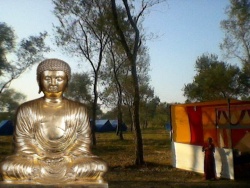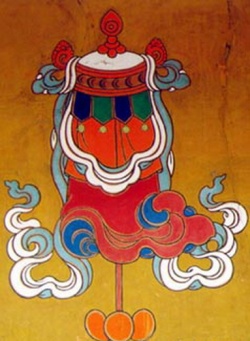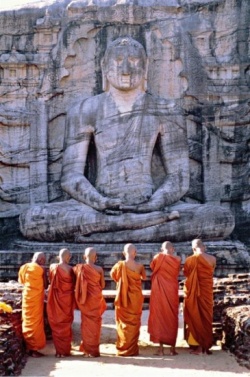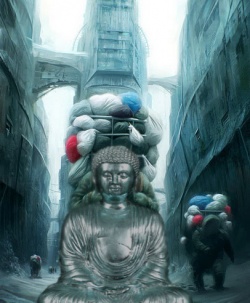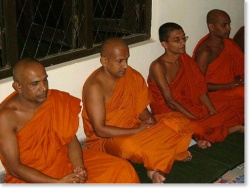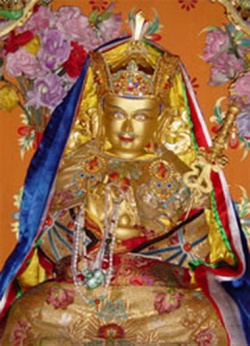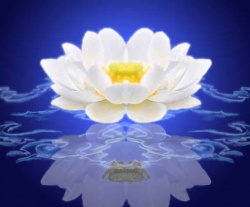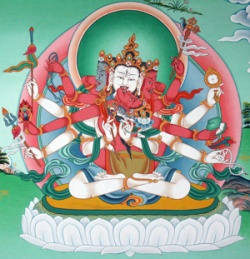Self-Release
By 'self-release', I'm not talking about a 'self' that is experiencing its own 'release'. On a conventional level we can talk about that -- for example, a Buddha or an arahant is one who experiences his own release. But at the same time a Buddha or an arahant already realizes that there is in fact no actually existing self behind anything. So what is release in that case? It is really just the release of clinging, of the sense of self, of mental afflictions (passion, aggression, delusion), and all thoughts, perceptions, experiences are released on the spot through lack of reification. Therefore it should be noted that 'self-release' is used here in that sense, not in the sense that there is a 'you' becoming liberated.
This 'release' is actually felt in every cell of the body so to speak - for example, having walked 24km or 72km with a 20kg load on one's back and finally putting it down (perhaps only people who went through army like me knows how that feels but anyway...), what release! Just because there is no self doesn't deny the experience of release (even though that too is empty), it just means there is no self who is experiencing or doing the release.
Now, just like the example above, the Dharma as taught by the Buddha is meant for release, but in this case the release of the mind. In the MN30, the Culasaropama Sutta, The Buddha states: "So this holy life, brahmin, does not have gain, honour, and renown for its benefit, or the attainment of virtue for its benefit, or the attainment of concentration for its benefit, or knowledge and vision for its benefit. But it is this unshakeable deliverance of mind that is the goal of this holy life, it heartwood, and its end." Ven. Thanissaro translates 'deliverance of mind' as 'awareness-release'.
The big question then is, how does mind releases?
As a method of practice, many teachings/teachers teaches us to just let thoughts and perceptions come and go without grasping them. As a practice that is OK -- but that is not the fundamental, definitive path of releasing thoughts and perceptions, and the sense of self. Usually, because of our strong dualistic tendencies, at the beginning it would be impossible not to fall into a situation where we feel ourselves to be the perceiver of our thoughts, and so the practice here is still somewhat dissociative - there is someone who can watch thoughts come and go or let go of thoughts or remain unaffected by them. When we become 'aware' or 'mindful', we feel ourselves to be on the alert as the aware watcher. But all these are really just forms of clinging in disguise of letting go. There is dualistic action involved - either I try to dissociate or get rid of thoughts - which is a subtler form of dualistic aggression appearing as 'letting go', or I grab onto them, which is a form of craving, or I remain as some unattached observer unaffected by thoughts or ignoring the comings and goings of thoughts, which is a form of dualistic ignorance and is also by definition 'dissociation'.
But it is ok for one's practice to be dualistic at first, because there is no way we can be 'non-dual' at the beginning of our practice. Telling someone about emptiness and nondual at the beginning of one's path may help direct one towards wisdom at least on an intellectual level, but not so much experientially, because karmic propensities are strong. So at first we have no choice but to practice dualistically. No choice because our karmic propensities which manifest this dualistic situation is driven by afflictive dependencies and ignorance, and is not a matter of free will - like anything really, everything manifests dependently and not through agency or control.
However, although one may practice mindfulness this way, if at the same time we have the right pointers and right view -- no-self, emptiness, D.O., and through one's own contemplations, eventually when the conditions ripen we will experience a breakthrough into the definitive path of release. Otherwise, if we merely have a practice but lack the right view, even when we awaken to a non-conceptual direct taste of Presence or Aware-clarity, it is often moulded into an Eternal Witness or an ultimate source and substratum expressing itself in all forms, which are subtler forms of 'spiritual bondage' or sense of self, which is not the definitive sort of awakening or liberation in Buddhadharma. This is why in Buddhadharma, the Buddha says that Right View is the forerunner of the noble eightfold path, it is in some ways even more important than all the other practices.
The definitive path of release starts with the realization that a seer, perceiver, controller or even a seeing, awareness etc has never existed as a self residing as the background of perception. Then one sees the true face of awareness has always been just manifestation empty of being some hidden unmanifest hidden ghostly unchanging independent self existing in and of itself, that in seeing theres just the seen without seer, there is no consciousness or seeing besides manifestation, perception naturally reveals itself in a nondual, self-luminous, direct fashion via the release of a center/agent vantagepoint. The imputation of a self or subject or inherent awareness dissolves into direct taste of transient manifestation. One can have peak experiences of no mind even before realization of anatta as an always already so dharma seal, but it will not be effortless and perpetual until after realization. Practice turns from dissociation with thoughts and perception to endless opening and letting sound/sight/etc 'kill you', and this is bliss.
Then after anatta we look at the thought itself or sensation or sound and realize that like a reflection that dependently originates in fact never arose, never came into existence. Then presence/reflection is experienced as illusory uncreated and deathless via its lack of inherency. Then thought self releases as there is no chaining and no identity that succeeds from moment to moment. Everything self liberates from tasting all phenomena as unborn.
As I paraphrased Thusness many years ago, “On the most direct path, there is no one to let go and no-thing to be let go of and hence no 'how to let go'. Reality is 'letting go' at all moments. There is only what arises and subsides (self-liberates) every moment according to conditions, luminous-empty phenomena roll on with no one at the center that can seek nor distant himself (since there is no 'self') from the self-knowing transience.” This direct path of self-release via non-action is only suitable for those actualizing twofold emptiness in all perceptions, otherwise it becomes the path of self-deluded slackers wallowing in deluded thoughts thinking it is liberation, the worst possible path. This is where Longchenpa warned, “In Ati these days, conceited elephants [claim] the mass of discursive concepts is awakened mind (bodhicitta); this confusion is a dimension of complete darkness, a hindrance to the meaning of the natural great perfection.”
But the key to release is not via resting in a state of clarity. Nor is it by subsuming object into subject or subject into object, one may experience non-division of subject and object in this way but it is not the same as releasing the reification of inherency of subject and inherency of object through emptiness and non-subsuming. Therefore when we talk about the non-duality of subject and object, we should be mindful that there is a difference between non-division and noninherency of those poles, they are different insights and have different impacts in one's experience.
Clarity/manifestation self liberates through discerning empty nature otherwise one resorts to dissociation and attempting to abide in a deemed purest state due to view of inherency. Worse still some book I read mistook self liberation as residing as an unaffected background of awareness while waves of thoughts arise and subside back to the sea. That is bondage in disguise of liberation. In truth anatta liberates background (releases the sense of a self residing as the background of experience) and twofold emptiness liberates foreground (even our non-conceptual pure sensory experiences, and all other experiences). Otherwise what liberation is there?
Actually this is really just a beginning. And I have merely summarized very shortly what is actually much more subtle. When we say "emptiness that releases"... we should not just limit our application of emptiness just to self, or to a particular aspect of phenomena.
For example, we can apply emptiness even in economics. As Thusness just wrote, "Money is dependent on its parts -- coins and paper and in the broader definition of money, visas and cheques.
Money is dependent on relations when extending beyond national boundaries in exchanges rates and interest rates.
Money is dependent on time, the time value of money.
Money is dependent on its functionality as medium of exchange, purge of this functionality; it is just paper can serve as a “pretty paper boat”.
Therefore money is empty!"
According to the Pali Canon, the practice of samadhi (concentration) has benefits. One of these is mindfulness and clear comprehension (sati sampajanna). That is merely seeing the arising and passing of phenomena (sankharas). This still leaves a sense of "I am" conceit or the witness/knower. But there is cannot be a subject without an object. They arise and ceased together. Without perception of impermanence, this cannot be seen.
The proper release comes from seeing causality (dependent coarising). The term used is - "such is ...."
That is what Ven. Khemaka did to remove conceit I am.
And what is the development of concentration that, when developed & pursued, leads to mindfulness & alertness? There is the case where feelings are known to the monk as they arise, known as they persist, known as they subside. Perceptions are known to him as they arise, known as they persist, known as they subside. Thoughts are known to him as they arise, known as they persist, known as they subside. This is the development of concentration that, when developed & pursued, leads to mindfulness & alertness.
And what is the development of concentration that, when developed & pursued, leads to the ending of the effluents? There is the case where a monk remains focused on arising & falling away with reference to the five clinging-aggregates: 'Such is form, such its origination, such its passing away. Such is feeling, such its origination, such its passing away. Such is perception, such its origination, such its passing away. Such are fabrications, such their origination, such their passing away. Such is consciousness, such its origination, such its disappearance.' This is the development of concentration that, when developed & pursued, leads to the ending of the effluents. These are the four developments of concentration.
"In the same way, friends, even though a noble disciple has abandoned the five lower fetters, he still has with regard to the five clinging-aggregates a lingering residual 'I am' conceit, an 'I am' desire, an 'I am' obsession. But at a later time he keeps focusing on the phenomena of arising & passing away with regard to the five clinging-aggregates: 'Such is form, such its origin, such its disappearance. Such is feeling... Such is perception... Such are fabrications... Such is consciousness, such its origin, such its disappearance.' As he keeps focusing on the arising & passing away of these five clinging-aggregates, the lingering residual 'I am' conceit, 'I am' desire, 'I am' obsession is fully obliterated."
Also in the Chachakka Sutta, the Buddha actually describe how the discerning of arsing and passing away leads to insight of anatta.
"If anyone were to say, 'The eye is the self,' that wouldn't be tenable. The arising & falling away of the eye are discerned. And when its arising & falling away are discerned, it would follow that 'My self arises & falls away.' That's why it wouldn't be tenable if anyone were to say, 'The eye is the self.' So the eye is not-self. If anyone were to say, 'Forms are the self,' that wouldn't be tenable... Thus the eye is not-self and forms are not-self. If anyone were to say, 'Consciousness at the eye is the self,' that wouldn't be tenable... Thus the eye is not-self, forms are not-self, consciousness at the eye is not-self. If anyone were to say, 'Contact at the eye is the self,' that wouldn't be tenable... Thus the eye is not-self, forms are not-self, consciousness at the eye is not-self, contact at the eye is not-self. If anyone were to say, 'Feeling is the self,' that wouldn't be tenable... Thus the eye is not-self, forms are not-self, consciousness at the eye is not-self, contact at the eye is not-self, feeling is not self. If anyone were to say, 'Craving is the self,' that wouldn't be tenable. The arising & falling away of craving are discerned. And when its arising & falling away are discerned, it would follow that 'My self arises & falls away.' That's why it wouldn't be tenable if anyone were to say, 'Craving is the self.' Thus the eye is not-self, forms are not-self, consciousness at the eye is not-self, contact at the eye is not-self, feeling is not self, craving is not-self.
"That is merely seeing the arising and passing of phenomena (sankharas). This still leaves a sense of "I am" conceit or the witness/knower. But there is cannot be a subject without an object"
A subject implies a self, but there never was an actual subject apart from an object, therefore the view that "there cannot be a subject without an object" is an erroneous view since it implies there must be an observer and observed although interdependent.
As a friend of mine wrote 4 years ago:
I used to think that the dichotomy of observer dependent on the observed held true, but all such distinctions themselves do not hold. Phenomena and awareness are one not because they are two elements, but both are characteristics of any experience in itself. Experience has always been non dual. Neither phenomena nor awareness can be found.
There never is/was a seer seeing scenery, the experience of scenery is consciousness, no consciousness besides the experience of scenery without seer. Everything is self-luminous, self-aware without seer or watcher of agent.
Piya Tan wrote: "Although in our daily language, it is common to speak of "knowing," “feeling,” "cognizing," or "perceiving" sense-objects, in the syntax of dependent arising, one does not really experience anything -- it simply is the experience that arises when the requisite conditions are present."
Thusness wrote: "Awareness is not like a mirror reflecting but rather a manifestation. Luminosity is an arising luminous manifestation rather than a mirror reflecting. The center here is being replaced with Dependent Origination, the experience however is non-dual.
One must learn how to see Appearances as Awareness and all others as conditions. Example, sound is awareness. The person, the stick, the bell, hitting, air, ears...are conditions. One should learn to see in this way. All problems arise because we cannot experience Awareness this way.
Conventionally we experience in the form of subject and object interaction taking place in a space-time continuum. This is just an assumption. Experientially it is not so. One should learn to experience awareness as the manifestation. There is no subject, there is only and always manifestation, all else are conditions of arising. All these are just provisional explanations for one to understand." -- http://awakeningtoreality.blogspot.sg/2009/06/bodhidharma-on-awareness-and-conditions.html
Most people say they are mindful of the arising and passing of phenomena, but it is nothing close to direct realization. Direct realization of impermanence is linked to direct realization of anatta and the eye of wisdom that apprehends impermanence *directly* that is the dharma eye.
Wisdom here is not a subject-object relationship -- i.e. not a someone being 'aware' of something. It is really just the experience itself dawning in its true nature (as opposed to being misperceived by delusion), self-revealed, self-aware, by being itself. The eye of wisdom knows impermanence by being-realizing impermanence, it is not a separate knower. This wisdom-realization that directly apprehends impermanence non-dually is true wisdom. Anything else is nothing direct, it cannot be called a realization. For example, 'noting' things as impermanent is not direct realization -- as there is still a sense of standing back and acknowledging things are impermanence.
When we realize anatta, even at the level of stream entry, there is no more view of a witness/knower. Why? Because the sense of a Subject, witness, knower lies with a view of self.
This is the false View no. 4 described in Sabbasava Sutta: "...As he attends inappropriately in this way, one of six kinds of view arises in him: The view I have a self arises in him as true & established, or the view I have no self... or the view It is precisely by means of self that I perceive self... or the view It is precisely by means of self that I perceive not-self... or the view It is precisely by means of not-self that I perceive self arises in him as true & established, or else he has a view like this: This very self of mine — the knower that is sensitive here & there to the ripening of good & bad actions — is the self of mine that is constant, everlasting, eternal, not subject to change, and will stay just as it is for eternity. This is called a thicket of views, a wilderness of views, a contortion of views, a writhing of views, a fetter of views. Bound by a fetter of views, the uninstructed run-of-the-mill person is not freed from birth, aging, & death, from sorrow, lamentation, pain, distress, & despair. He is not freed, I tell you, from suffering & stress." - the commentary of 'Middle Length Discourses' book explains, "of these six views, the first two represent the simple antinomy of eternalism and annihilationism; the view that ‘no self exists for me’ is not the non-self doctrine of the Buddha, but the materialist view that identifies the individual with the body and thus holds that there is no personal continuity beyond death. The next three views may be understood to arise out of the philosophically more sophisticated observation that experience has a built-in reflexive structure that allows for self-consciousness, the capacity of the mind to become cognizant of itself, its contents, and the body with which it is inter-connected. Engaged in a search for his 'true nature,' the untaught ordinary person will identify self either with both aspects of the experience (view 3), or with the observer alone (view 4), or with the observed alone (view 5). The last view is a full-blown version of eternalism in which all reservations have been discarded."
So it is in fact, the sense of a background agent, Witness, Knower, that is the first to go in stream entry. The 'Witness/Knower' is not the last to go, it is a self-view that is terminated at stream entry. I can tell you from my experience that the sense of a Witness or Knower has been terminated for 4 years -- not a single moment have I felt for all these years that there is a Witness or Knower 'in here' or behind things that is seeing and controlling things, everything is just self-felt, self-seen, manifesting according to conditions on its own without agency or a someone inside my head looking outwards. Yet I do not see myself as an arahant, although a DhO community moderator has said that my experience is equivalent to arahantship in their terminology.
Unfortunately many people like Daniel Ingram sees realization of anatta as the end and disregard the fetter model -- I see it as just a beginning.
The remaining 'I am conceit' is not a kind of view, but any kind of remaining sense of ownership, possessiveness, attachments, identifications, cravings, attachments arising out of habitual karmic patterns. For example, one may no longer have any view that I am my body, or that I am consciousness, or that I am the 'witness', yet if someone is going to kill that person, fear may still arise due to karmic propensities due to a trace of possessiveness of the body. It is a kind of trace even though they have realized there is no self within or apart from the body in any forms including as a knower.
So what is the difference between the 'view of self' and the 'trace of self'?
Realizing anatta does not mean that at once you will overcome all sense of grasping and mine-making. Although after realization of anatta there is no longer the grasping at a "background I" or agency, it does not mean there is no grasping at other aspects like 'mine' or clinging to forms of thought patterns.
I remember Newbuddhist Richard said that his grasping is not so much about a transcendental Self but the pains he felt as a father caring for his son when his son got bullied etc.
As for me, although I have not faced such things yet (as I am not a father), I still think my anatta need to complement with shamatha and dispassion and letting go to overcome all thought patterns. Even if the universe is about to end... hopefully, may I experience release.
How have you been getting on? I am planning for my retirement.
I think after stabilizing non-dual experience and maturing the insight of anatta, practice must turn towards ‘self-releasing’ and ‘dispassion’ rather than intensifying ‘non-dual’ luminosity. Although being bare in attention or naked in awareness will help in dissolving the sense of ‘I’ and division, we must also look into dissolving the sense of ‘mine’. In my opinion, dissolving of the sense of ‘I’ does not equate to dissolving the sense of ‘mine’ and attachment to possessions can still be strong even after very stable non-dual experience. This is because the former realization only manages to eliminate the dualistic tendency while the latter requires us to embody and actualize the right view of ‘emptiness’. Very seldom do we realize it has a lot to do with our ‘view’ that we hold in our deep most consciousness. We must allow our luminous essence to meet differing conditions to realise the latent deep. All our body cells are imprinted and hardwired to ‘hold’. Not to under-estimate it.
When we realize anatta, even at the level of stream entry, there is no more view of a witness/knower. Why? Because the sense of a Subject, witness, knower lies with a view of self.
So it is in fact, the sense of a background agent, Witness, Knower, that is the first to go in stream entry. The 'Witness/Knower' is not the last to go, it is a self-view that is terminated at stream entry.
The view of self is no more but that lingering sense/scent of a background agent ie. the one who knows is still there. As Khemaka states - the scent is there but you can't call it scent of the filaments, petals etc. But he keeps on observing dependent coarising (Such is .....) over and over and over until the scent is washed out.
"Friends, it's not that I say 'I am form,' nor do I say 'I am something other than form.' It's not that I say, 'I am feeling... perception... fabrications... consciousness,' nor do I say, 'I am something other than consciousness.' With regard to these five clinging-aggregates, 'I am' has not been overcome, although I don't assume that 'I am this.'
"It's just like the scent of a blue, red, or white lotus: If someone were to call it the scent of a petal or the scent of the color or the scent of a filament, would he be speaking correctly?"
"No, friend."
"Then how would he describe it if he were describing it correctly?"
"As the scent of the flower: That's how he would describe it if he were describing it correctly."
"In the same way, friends, it's not that I say 'I am form,' nor do I say 'I am other than form.' It's not that I say, 'I am feeling... perception... fabrications... consciousness,' nor do I say, 'I am something other than consciousness.' With regard to these five clinging-aggregates, 'I am' has not been overcome, although I don't assume that 'I am this.'
"Friends, even though a noble disciple has abandoned the five lower fetters, he still has with regard to the five clinging-aggregates a lingering residual 'I am' conceit, an 'I am' desire, an 'I am' obsession. But at a later time he keeps focusing on the phenomena of arising & passing away with regard to the five clinging-aggregates: 'Such is form, such its origin, such its disappearance. Such is feeling... Such is perception... Such are fabrications... Such is consciousness, such its origin, such its disappearance.' As he keeps focusing on the arising & passing away of these five clinging-aggregates, the lingering residual 'I am' conceit, 'I am' desire, 'I am' obsession is fully obliterated.
The Chachakka Sutta describes what needs to happen to put an end to dukkha through elimination of greed, hatred and delusion. It is the seeing of the true nature of samsara that leads to a turning away from it.
"Dependent on the eye & forms there arises consciousness at the eye. The meeting of the three is contact. With contact as a requisite condition, there arises what is felt either as pleasure, pain, or neither pleasure nor pain. If, when touched by a feeling of pleasure, one does not relish it, welcome it, or remain fastened to it, then one's passion-obsession doesn't get obsessed. If, when touched by a feeling of pain, one does not sorrow, grieve, or lament, beat one's breast or become distraught, then one's resistance obsession doesn't get obsessed. If, when touched by a feeling of neither pleasure nor pain, one discerns, as it actually is present, the origination, passing away, allure, drawback, & escape from that feeling, then one's ignorance-obsession doesn't get obsessed. That a person — through abandoning passion-obsession with regard to a feeling of pleasure, through abolishing resistance-obsession with regard to a feeling of pain, through uprooting ignorance-obsession with regard to a feeling of neither pleasure nor pain, through abandoning ignorance and giving rise to clear knowing — would put an end to suffering & stress in the here & now: such a thing is possible.
"Seeing thus, the well-instructed disciple of the noble ones grows disenchanted with the eye, disenchanted with forms, disenchanted with consciousness at the eye, disenchanted with contact at the eye, disenchanted with feeling, disenchanted with craving.
What Khemaka Sutta describes is not the 'agent'. The agent is the first to go. After realizing anatta, there is no more sense of an agent. I do not have any sense of an agent even typing right now, just the vivid action of typing, the seeing that is merely the words appearing, without any kind of actor or seer.
The trace of 'self' is not a view of self -- including an agent. It is any sense of self that arises as a trace as a result of subtle possessiveness and identifications, like for example, unwillingness to part with one's loved ones and belongings.
